In our latest update from our journey through the stunning mountainous region of Huangshan in China’s Anhui Province, we’re delighted to introduce you to the enchanting Emerald Valley before we dive into the culinary highlight of our (food) trip.
The Emerald Valley Scenic Area (翡翠谷风景区) in Huangshan is a picturesque nature reserve located in the southeastern part of the Huangshan Mountains, near the village of Tangkou. Famous for its crystal-clear emerald pools fed by numerous streams and waterfalls, the valley offers a breathtaking natural setting. Well-maintained hiking trails, lush vegetation and abundant wildlife make it a popular destination for nature lovers and tourists alike.
Whether you’ve conquered the peaks of the Yellow Mountains or explored the historic charms of Hongcun’s Old Town, Emerald Valley is the perfect retreat for relaxation.

We stayed in a charming, quaint hotel on the G205 road near the Jiulong Waterfalls, which meant that some of the attractions of Emerald Valley were just a short drive or pleasant stroll away.
On the one hand, we were eager to explore the Jade Valley, also known as Fei Cui Valley (翡翠谷) or Lovers’ Valley. On the other hand, we were captivated by the even more famous Jiulong Waterfalls (Jiǔlóng Pùbù 九龙瀑布), also known as the Nine Dragons Waterfalls.
The Jade or Emerald Valley, also known as Fei Cui Valley (翡翠谷) or Lovers’ Valley, is a picturesque gorge that winds through the mountainous landscape of the Huangshan Mountains for about 20 kilometres. Along the way, a path leads past countless natural pools and water features of various shapes and sizes – from small ponds to rushing waterfalls – inviting visitors to stop and enjoy the scenery. Despite their allure, swimming is forbidden here to protect the water, which is a vital local source of drinking water.

Depending on the time of day, the sunlight and the surrounding landscape, these water features display a spectrum of colours reminiscent of shimmering jade or emeralds scattered throughout the gorge, giving the valley its evocative name.




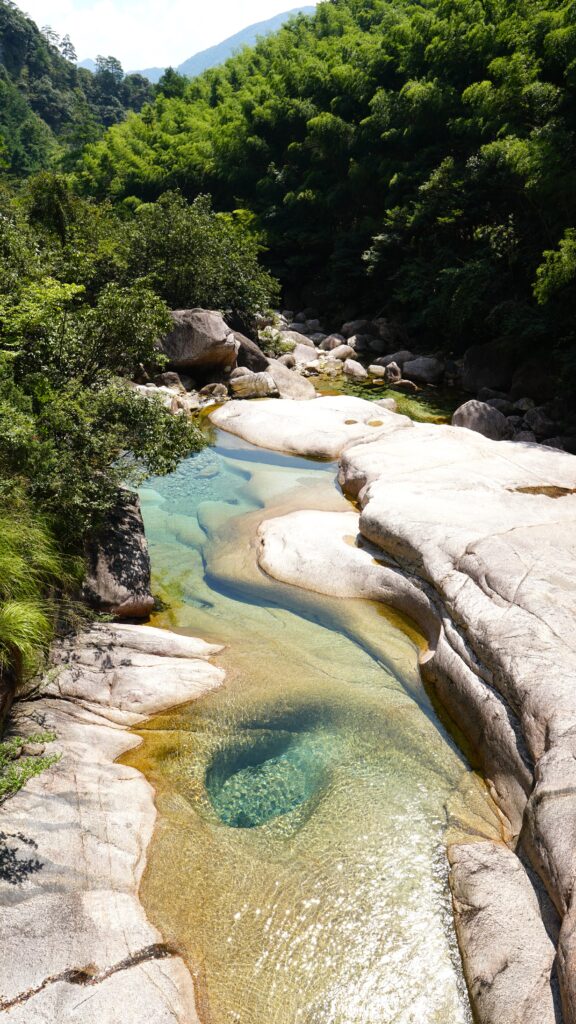
The idyllic beauty and romantic atmosphere of the valley make it a popular destination for couples.
Its nickname is reflected in many details, such as a small bridge where each step represents a different phase of a romantic relationship, or a hiking trail with different symbols of love.


The valley is also of great cultural significance and is depicted in classic Chinese poems, paintings and scrolls. These works of art express the appreciation of the valley’s natural beauty and its role as a place of spiritual reflection, making it a symbol of harmony between man and nature.
It became famous through various scenes in the Oscar-winning film “Crouching Tiger, Hidden Dragon”. Notable scenes include fierce battles in the bamboo forests and romantic love scenes at one of the many water spots.



The Jiulong Waterfalls (Jiǔlóng Pùbù 九龙瀑布) are renowned for their majestic beauty and the mighty torrent that plunges over a series of terraces and cliffs into the depths below.

The name “Jiulong” literally means “Nine Dragons“, derived from the shape of the waterfalls. According to legend, it looks as if nine dragons are plunging into the valley from the sky. It is a breathtaking natural spectacle, especially after heavy rainfall, when the water roars and crashes down the rocks.
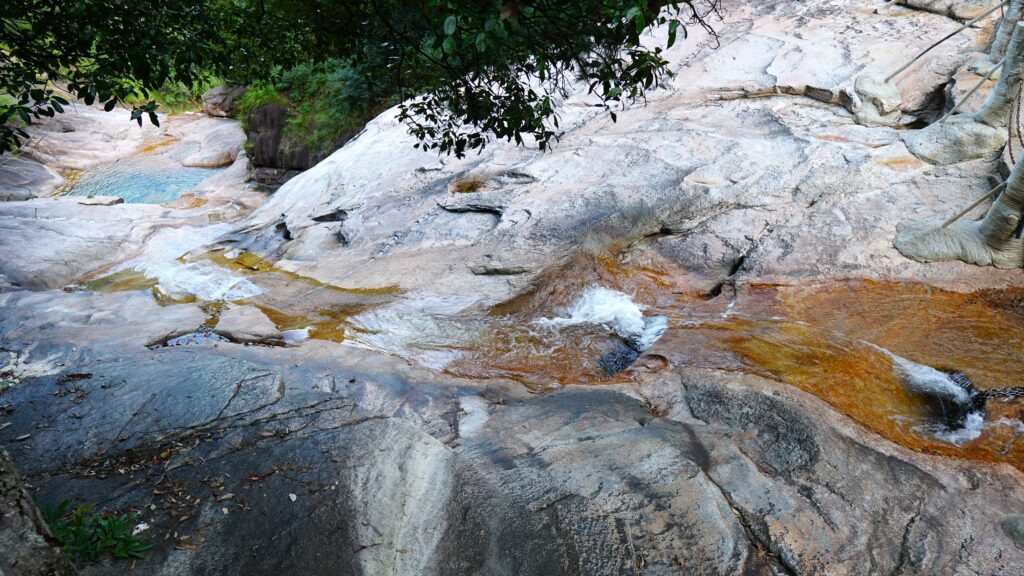

The waterfalls captivate nature lovers and adventurers alike and attract thousands of visitors every year. Surrounded by a rich variety of plants and trees, the Jiulong Waterfalls offer a breathtaking display and an opportunity to experience the splendour of Huangshan Mountain in its purest form. Numerous hiking trails wind through the surrounding forests, allowing hikers to discover the beauty of the waterfalls from different perspectives.



The ascent (find a route here) begins at a quaint temple and winds past several historic structures before crossing a picturesque bridge under which a stream fed by the waterfall flows.


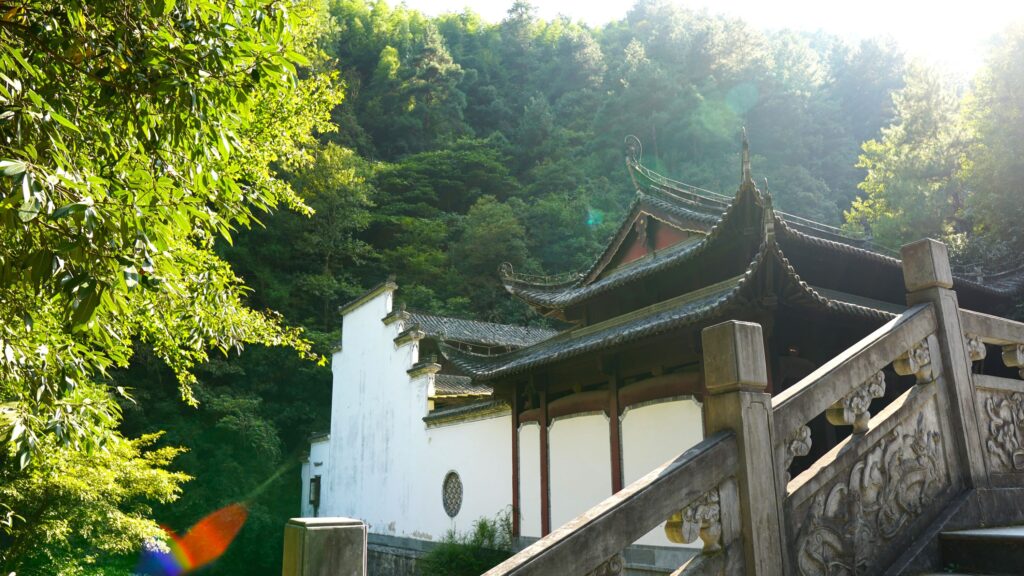
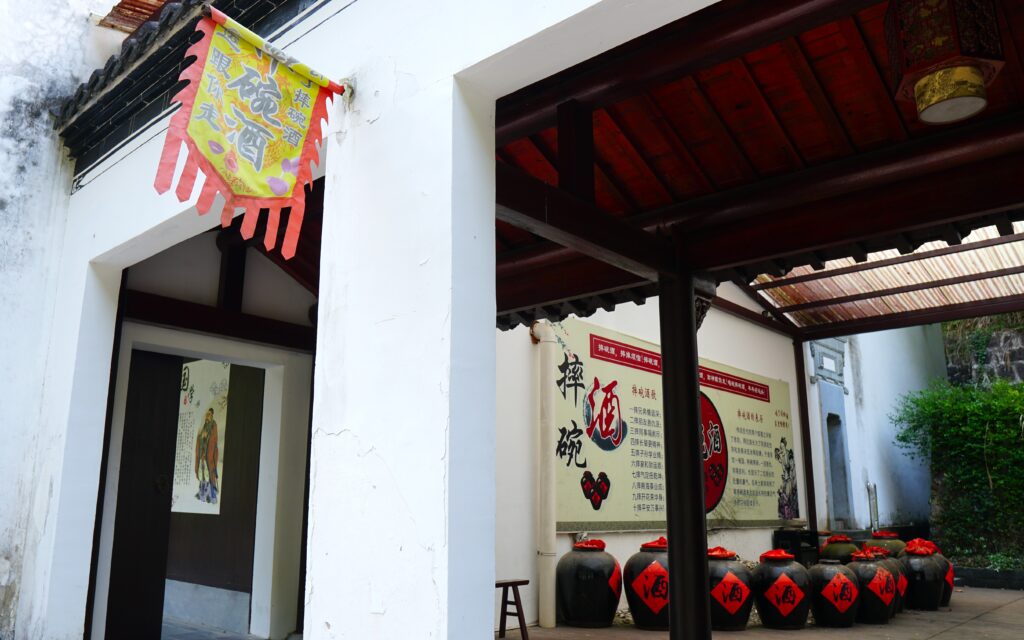
However, the pinnacle of the journey awaits at the very end: a deep natural pool nestled beneath several steep waterfalls. Here, one can marvel at the torrents rushing down the steep slopes with remarkable velocity. It’s truly worthwhile to linger here, soaking in the wild scenery before embarking on the descent.
Tips for your visit:
- Duration: Both the Jade Gorge and the Jiulong Waterfalls take about half a day each, so you can easily visit both attractions in one day.
- Getting there: From the town of Tangkou at the foot of the Yellow Mountains, you can reach the Emerald Valley in a few minutes by car. It’s best to take a taxi or arrange transport (e.g. through your hotel reception).
- Entrance fees: You can buy tickets for the nature parks on the spot or in advance at your hotel. Prices range from 50 to 100 RMB per person, depending on the season or special offers.
- Gear: Sturdy, comfortable footwear and clothing suitable for the weather (a light rain jacket or poncho) are recommended as the trails can be steep and slippery. It is a good idea to bring water and snacks, as these tend to be more expensive in the field. And, above all, don’t forget your camera or smartphone to capture all those breathtaking moments!
- Respect nature: Visitors are urged to respect the local flora and fauna and to avoid littering. Many areas have loudspeakers or signs to emphasise this. Fines can be imposed if the rules are not followed.
After two long walks, we were getting hungry. The owner of our hotel once again demonstrated his culinary skills. Overall, we were very lucky with our accommodation and its very dedicated owner. He told us a fascinating story of his social rise and how he saved up enough money to buy this hotel in Huangshan. He now enthusiastically organises walking routes, arranges tickets and personally guides his guests to the main attractions. A truly enriching experience! But now on to the food …
Gānguō Tǔjī (干锅土鸡) or Dry Pot Chicken is a traditional Chinese dish known for its intense aroma and spicy flavor. The term “Gānguō” literally means “dry pot” and refers to a specific cooking technique in which ingredients are stir-fried in a very hot cast-iron pot or pan (find similar dishes at China Haus in Frankfurt). Tǔjī ‘土鸡’ refers to free-range chicken, which is prized for its firm texture and rich flavor.

The chicken is cut into bite-sized pieces and stir-fried with a variety of spices such as dried chili peppers, garlic, ginger and Sichuan peppercorns, then garnished with fresh spring onions. Stir-frying in a hot pot gives the meat a crispy exterior while keeping the interior juicy and tender.
Tiàoshuǐyú (跳水鱼), also known as “Jumping Fish“, is a traditional Chinese delicacy known for its intense flavor and spicy heat.

Fresh fish is cooked in a spicy broth of chili, pepper and various other spices and served directly in the hot broth. This broth is enriched with a variety of spices and herbs that enhance its characteristic flavor. This preparation gives the fish a tender texture and allows it to fully absorb the rich flavors of the broth. The dish is served with vegetables, mushrooms and garnished with garlic, spring onions and especially hot pickled chili peppers.
Braised stinky tofu (红烧臭豆腐, Hóng Shāo Chòu Dòufu) – or red-braised stinky tofu – is a popular dish in Chinese cuisine. It consists of fermented tofu, which is famous for its distinctive smell, often perceived as unpleasant (perhaps you remember the stinky tofu from Wuhan?). Despite its odor, chòu dòufu is known for its unique and rich umami flavor that develops during the fermentation process.

The fermented tofu is fried and then braised in a savory, dark sauce made from soy sauce, sugar, garlic, ginger, and chili. The sauce adds a tangy heat and pleasant sweetness that complements the robust flavor of the fermented tofu.
For added freshness, the chef has sprinkled some scallions over the tofu.
Let’s now move on to the culinary highlight of this trip: “石耳炖石鸡” (Shíěr Dùn Shíjī) – loosely translated as “Steamed Chicken with Mushrooms” – is a traditional Chinese dish from Guizhou Province. It is an incredibly aromatic dish in which a whole chicken is cooked with mushrooms such as shiitake or porcini. Not only does it look spectacular, but it also tastes incredibly delicious.

The preparation starts with soaking dried mushrooms. Then the chicken is slowly simmered with the mushrooms and various spices, such as ginger, garlic, and soy sauce, until everything is tender and the flavors of the chicken and broth blend beautifully. The result is a rich, incredibly flavorful stew with a deep, umami-rich broth, garnished with fresh scallions, and served with rice as a carbohydrate base. After enjoying the mild and soothing braised chicken, you’ll feel pleasantly warm and full from its richness – ideal after a long hike in the Huangshan Mountains.
This dish is not only known for its taste, but also for its health benefits, as the mushrooms are rich in nutrients and the chicken is a good source of protein.
Finally, I would like to introduce you to some healthy and delicious vegetable dishes.
Let’s start with cooked Mǎlántóu (马兰头), also known as Kalimeris indica, which offers a taste slightly reminiscent of chrysanthemum leaves, but milder. Found mainly in East Asia, this plant thrives in the mild climate and pristine environment of the Huangshan Mountains, preferring moist, shady locations and thriving in forested, hilly areas.
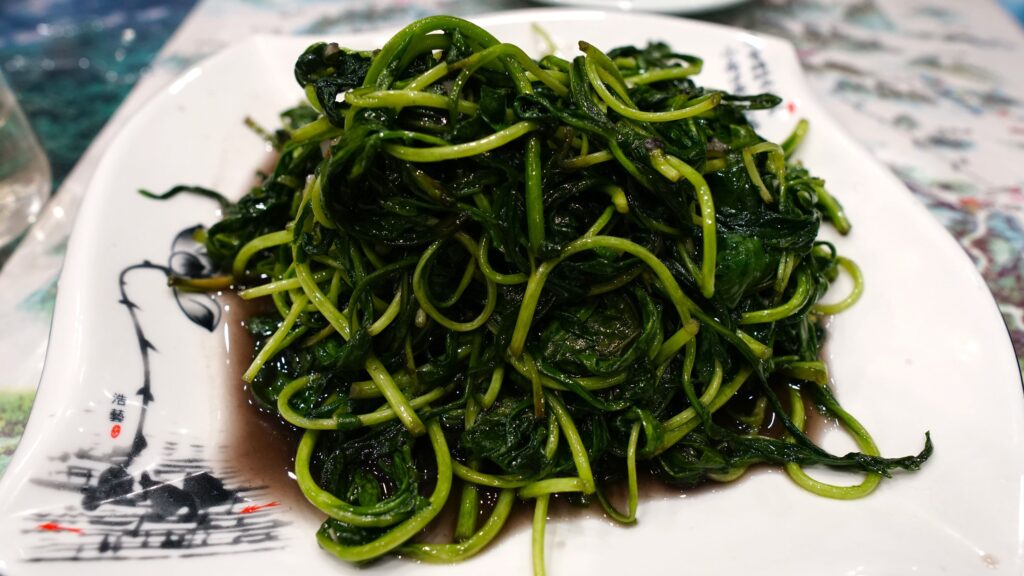
Its tender leaves and shoots are carefully harvested and blanched in boiling water to retain their vibrant green color and delicate, slightly bitter flavor. It is then seasoned with garlic and sesame oil. In addition to its culinary appeal, mǎlántóu holds an important place in Traditional Chinese Medicine (TCM) for its abundance of vitamins, minerals, and antioxidants, which are believed to have anti-inflammatory and detoxifying properties.
Another vegetable worth mentioning is Shuiqin (水芹), commonly known as water celery. It’s prized in Chinese cuisine for its crisp, juicy texture, similar to celery, but with a more intense flavor and a hint of bitterness.

In traditional Chinese medicine, water celery is valued for its cooling and diuretic effects, which promote yin in the body and help relieve heat.
With its growing global popularity, water celery is now readily available in supermarkets and Asian grocery stores, lending its versatility to a wide range of healthy dishes.
This concludes our journey through the breathtaking scenery of Huangshan. I hope you’ve enjoyed our experiences with the local nature and cuisine. See you soon for more adventures in China and around the world!




